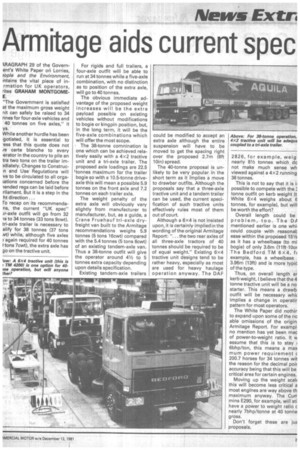Armitage aids current spec
Page 15

If you've noticed an error in this article please click here to report it so we can fix it.
kRAGRAPH 29 of the Governent's White Paper on Lorries, ?ople and the Environment, intains the vital piece of inrmation for UK operators, rites GRAHAM MONTGOMEE.
"The Government is satisfied at the maximum gross weight lit can safely be raised to 34 nnes for four-axle vehicles and 40 tonnes on five axles," it ys.
While another hurdle has been gotiated, it is essential to .ess that this quote does not re carte blanche to every ,erator in the country to pile an tra two tons on the trailer immliately. Changes to Construen and Use Regulations will ve to be circulated to all orga;ations concerned before the iended regs can be laid before rliament. But it is a step in the ht direction ...
fo recap on its recommendans, the current "UK spec" Jr-axle outfit will go from 32 ls to 34 tonnes (33 tons 9cwt). tri-axle trailer is necessary to alify for 38 tonnes (37 tons Art) while, although five axles again required for 40 tonnes I tons 7cwt), the extra axle has go on the tractive unit. For rigids and full trailers, a four-axle outfit will be able to run at 34 tonnes while a five-axle combination, with no distinction as to position of the extra axle, will go to 40 tonnes.
The obvious immediate advantage of the proposed weight increases will be the extra payload possible on existing vehicles without modifications to bogie or kingpin position, but, in the long term, it will be the five-axle combinations which will offer the most scope.
The 38-tonne comnination is one which can be achieved relatively easily with a 4x2 tractive unit and a tri-axle trailer. The proposed axle loadings are 22.5 'tonnes maximum for the trailer bogie so with a 10.5-tonne driveaxle this will mean a possible 5.9 tonnes on the front axle and 7.2 tonnes on each trailer axle.
The weight penalty of the extra axle will obviously vary slightly from manufacturer to manufacturer, but, as a guide, a Crane Fruehauf tri-axle dryfreight van built to the Armitage recommendations weighs 5.9 tonnes (5 tons 16cwt) compared with the 5.4 tonnes (5 tons ficwt) of an existing tandem-axle van. Thus a 38-tonne outfit will give the operator around 41/2 to 5 tonnes extra capacity depending upon details specification.
Existing tandem-axle trailers could be modified to accept an extra axle although the entire suspension will have to be moved to get the spacing right over the proposed 2.7m (8ft 10in) spread.
The 40-tonne proposal is unlikely to be very popular in the short term as it implies a move to drawbar outfits. Although the proposals say that a three-axle tractive unit and a tandem trailer can be used, the current specification of such tractive units effectively rules most of them out of court.
Although a 6x4 is not insisted upon, it is certainly implied in the wording of the original Armitage Report: "... the two rear axles of all three-axle tractors of 40 tonnes should be required to be of equal weight." Existing 6X4 tractive unit designs tend to be rather heavy, especially as most are used for heavy haulage operation anyway. The DAF
2826, for example, weig nearly 81/2 tonnes which dc
not make much sense wh viewed against a 4X2 running 38 tonnes.
This is not to say that it is ii possible to compete with the tonne outfit on kerb weight (t White 6x4 weighs about 6 tonnes, for example), but will be worth the effort?
Overall length could be problem, too. The DA mentioned earlier is one whi, could couple with reasonat ease within the proposed 151/2 as it has a wheelbase (to mi bogie) of only 3.6m (lift 10or The Bedford TM 6X4, fc example, has a wheelbase 3.96m (13ft) and is more typic of the type.
Thus, on overall length ar kerb weight, I believe that the 4 tonne tractive unit will be a no starter. This means a drawb. outfit will be necessary whir implies a change in operatir pattern for most operators.
The White Paper did nothir to expand upon some of the no able omissions of the origin Armitage Report. For exampl no mention has yet been mac of power-to-weight ratio. It v% assume that this is to stay 6bhp/ton, this means a max mum power requirement r 200.7 horses for 34 tonnes wit the reason for the decimal poir accuracy being that this will be critical area for certain engines.
Moving up the weight scalt this will become less critical a most engines are way above th maximum anyway. The Curr mins E290, for example, will sti have a power to weight ratio c nearly 7bhp/tonne at 40 tonne gross.
Don't forget these are jig proposals.










































